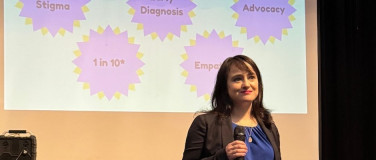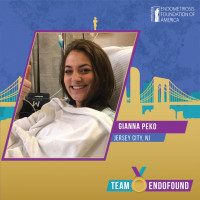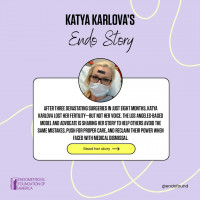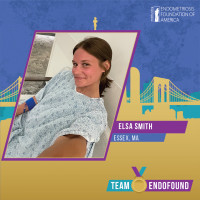
After months on the waitlist in Canada, Jennifer Todd booked a flight to Mexico for surgery that she’d pay out of pocket for. This wasn’t her first endometriosis surgery, but this one would massively improve her quality of life.
“Prior to surgery, I felt completely overwhelmed and defeated. I had to take medical leave from my job while I waited for surgery,” Todd said. She said it was a very stressful decision to travel for surgery and find a surgeon she trusted.
At 37 years old, she was exhausted, physically and emotionally. “Not being able to work and contribute to my household in the way I wanted to was very upsetting. I felt embarrassed and ashamed that I couldn’t manage my pain enough to maintain my job, care for my child or participate in family events. I only had 3-5 days per month where I knew I would feel okay to go out. It was so isolating,” Todd said.
After her first excision surgery, Jennifer’s healthcare team recommended a hysterectomy to help manage her adenomyosis, a sister condition to endometriosis where lesions are found inside the uterus. But Jennifer still hoped for another baby. This choice between potential pregnancy or potential relief from debilitating pain is a dilemma so many with endometriosis and adenomyosis face. The heartbreaking reality is that neither outcome is guaranteed, particularly with endometriosis, where a hysterectomy will often only grant relief if the disease is properly excised beyond the uterus.
“I tried to get pregnant for 18 months but was unsuccessful and my pain had increased substantially so, in discussion with my surgeon, we decided it was time for a hysterectomy,” she said. Jennifer underwent a hysterectomy and oophorectomy, where both her uterus and ovaries were removed, along with endometriosis excision and bowel resection. She voiced that while it was difficult to accept the finality of no longer being able to get pregnant again, “the constant pain was definitely harder to deal with on a daily basis.”
When Surgery Triggers Menopause
In the U.S., about 600,000 hysterectomies are performed each year. About 100,000 of those are for endometriosis. Although a hysterectomy doesn’t effectively treat endometriosis (as endometriosis exists outside the uterus), many patients are guided towards the procedure as a last-resort option when symptoms are unmanageable and severely impact their quality of life.
If the ovaries are removed as well, this procedure will trigger surgical menopause. Unlike natural menopause, which occurs gradually over years, surgical menopause is abrupt and characterized by a sudden and complete drop of estrogen and progesterone. This sudden change can cause symptoms like hot flashes, insomnia, irritability, weight gain, fatigue, low libido, anxiety, and depression. And when performed in patients under 35, a hysterectomy also carries long-term health risks, including increased risk of heart disease.
In people with endometriosis, this transition can be especially complex. Many are left balancing two realities: potential relief from period pain due to the removal of the uterus and ovaries, and the onset of new symptoms brought on by the subsequent hormone loss.
For Jennifer, hormone replacement therapy (HRT), became essential. “HRT has changed my life in such a positive way but it hasn’t come without its challenges. It took nearly a year to find the right combination of hormones and the right doses to help me feel like myself,” Todd said. She later realized she’d likely been in perimenopause for years, since her first excision surgery.
“There also isn’t a lot of research regarding endometriosis reoccurrence with those taking HRT following excision surgery so that is a bit nerve wracking as well,” Todd added. Her experience is not uncommon. Many people with endometriosis feel alone navigating HRT after hysterectomy, unsure how to balance symptom relief with the risk of recurrence.
A Different Path
Patricia Kirsch underwent a hysterectomy and bilateral oophorectomy at 50 years old, after years of living with endometriosis. “My doctor warned me that taking my ovaries would throw me straight into menopause,” she said. “I didn't care at that point and foolishly thought I'd be fine.”
But recovery was harder than she imagined. “The hot flashes and the fatigue and the surgery recovery made me angry, uncomfortable and depressed,” Kirsch said. She was sore, in pain, and even sleep became difficult.
Patricia was recommended HRT for relief, but she declined. “My doctor had told me I still had some deep infiltrating endometriosis lesions that she wasn't able to remove. I didn’t want to inflame them or make them grow with estrogen,” she said.
The experience also brought emotional challenges and complex grief. “I've never had children and when I understood that I would never become a mother, I cried. I grieved for that part of my life that would never be.” Kirsch said. There she was, recovering from this radical surgery while dealing with the physical and emotional changes in her body, heart, and mind. In addition to the grief, she was angry, too.
Surgery often marks the end of one challenge and the beginning of another. The physical, emotional, and hormonal effects of surgical menopause are profound, yet many patients report feeling deeply unprepared. Even without surgery, perimenopause and menopause can be overwhelming. Add in the complexities of endometriosis and HRT, and the transition can feel like navigating uncharted territory.
The decision to have a hysterectomy and oophorectomy for endometriosis is rarely simple. The very surgery meant to bring relief from debilitating disease can introduce a new set of problems including, but not limited to uterine prolapse, mood instabilities, joint pain, loss of bowel and bladder control. A fool’s choice, some might say, when the treatment options offered never feel like true healing. Both require sacrifice, and sometimes the relief never arrives.
“It's been over a year since my surgery, and I continue to struggle with physical and emotional issues,” Patricia said. She presents a harsh paradox: relief comes with a cost. Hysterectomy is not a cure for endometriosis and can carry more challenges, yet for Patricia, the procedure was ultimately the right one for her health at this moment of her life. “I can manage my symptoms now and I know I'll get through menopause in time.”







